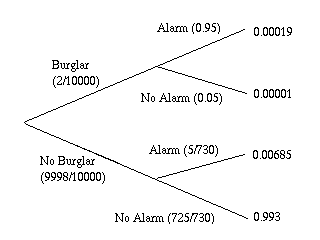Selected Answers to Problem Set 4
1) Here's a link to Prof. Kazdan's explanation in PDF format. This should offer a better explanation than I can offer, especially how this is in PDF format (and HTML doesn't allow that much ability to demonstrate math).
2. This problem nearly tore the class apart last semester and,
according to Dr. Kazdan, had made its way through the corridors of DRL as
well. On a stick of length one, the conditions are such:
i) If I assign z to be the longest, then x + y > zKnowing these to be true, for any cut c1 that I make on the stick, it denotes a range of possible cuts that will yield three pieces which will make a triangle (that is, three pieces all of which are less than 1/2).
ii) if x + y + z = 1, then x + y = 1 - z
iii) Therefore, by substitution, 1 - z > z, or z < 0.5
iv) Moreover, no piece can be longer than 0.5
i) c1 < 1/2From this, we can see that if we make a cut c1 then the odds that c2 will fall in between 1/2 and (c1 + 1/2) is exactly c1. Of course, we cannot make a cut past one, so when c1 is past 1/2, c2 will be between (c1 - 1/2) and 1/2. We can instead take the integral of all values of c1 between 0 and 1/2 and multiply by two.
ii) c2 - c1 < 1/2 => c2 < c1 + 1/2
iii) 1 - c2 < 1/2 => c2 > 1/2
iv) Therefore, 1/2 < c2 < c1 + 1/2

P, then, equals 1/8. Multiplied by two yields the answer, 1/4, or 25%.
3. A markov matrix can be constructed to simulate the answers. This matrix will contain in each column (which adds up to
1) the probability that a person will say yes or no, depending on whether the person was told yes or no.

The number of people in line who were told yes would be calculated by taking A^n, as n approaches infinity. Therefore A^n =

This leaves 2/3 of the line hears yes, while 1/3 hears no tickets are left. I bet you didn't know that your professor likes Limp Bizkit...
A better example: suppose that we have a certain percentage of yes people
(y) and a certain percentage of no people (n). After these people
tell the next people, we can assume that the ratio should not change with a
large number of people. Therefore:
0.8y + 0.4n = yTake the four coefficients in the equation into a matrix and multiply it by a vector (y,n). You know that the matrix multiplied by the vector will yield the vector: Av = v. Find the eigenvector of this matrix to find v, which is both (y,n) and your answer.
0.2y + 0.6n = n
4. This problem is very simliar to problems in the past, such as
the female smokers problem and the cancer problem.
